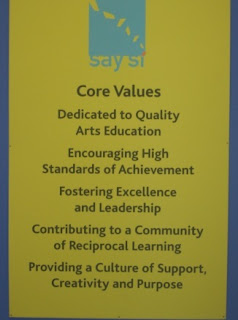 #1) Investment in our future: From large urban cities to small rural towns, research shows that the nonprofit arts are an economically sound investment. Young people who participate in the arts for at least three hours on three days each week: Create better citizens, “A U.S. Department of Justice study reported participation in arts programming led to decreased deliquency and drug use, increased self-esteem, and more postitive interactions with peers and adults.”^ Students who have education rich in the arts also have better attitudes about community service. Low-income students that are engaged in the arts are more likely to have attended and done well in college, obtained employment with a future, volunteered in their community and participated in the political process by voting than their non-arts-engaged peers.
#1) Investment in our future: From large urban cities to small rural towns, research shows that the nonprofit arts are an economically sound investment. Young people who participate in the arts for at least three hours on three days each week: Create better citizens, “A U.S. Department of Justice study reported participation in arts programming led to decreased deliquency and drug use, increased self-esteem, and more postitive interactions with peers and adults.”^ Students who have education rich in the arts also have better attitudes about community service. Low-income students that are engaged in the arts are more likely to have attended and done well in college, obtained employment with a future, volunteered in their community and participated in the political process by voting than their non-arts-engaged peers.#2) Improved academic performance- Students with an education rich in the arts have higher GPAs and standardized test scores, lower drop-out rates and these benefits are achieved by students regardless of socio-economic status. Children motivated by the arts develop attention skills and strategies for memory retrieval that also apply to other academic subject areas such as math and science.
“ I credit my time in theatre with giving me the discipline to become a merit scholar”-
Dennis Perez, sophomore, University of the Incarnate Word
#3) Enrich our community: “The arts enrich our experience of life - they bring color, passion, beauty and intensity to our lives. They are a source of pleasure, entertainment and relaxation and a means of escape from the day to day.” "Arts Debate" “University of Pennsylvania researchers have demonstrated that a high concentration of the arts in a city leads to higher civic engagement, more social cohesion, higher child welfare, and lower poverty rates.”#4) Preparing Students for the Workplace: Schools and employers rank a degree in the arts as the most significant indicator of a job candidate’s creativity and skills of innovation. Creativity is among the top applied skills sought by employers. “The arts—music, creative writing, drawing, dance—provide skills sought by employers of the 3rd millennium.”
 #5) Good for our Health: Nearly one-half of the nation’s healthcare institutions provide arts programming for patients, families, and even staff, 78 percent deliver these programs because of their healing benefits to patients—shorter hospital stays, better pain management, and less medication.
#5) Good for our Health: Nearly one-half of the nation’s healthcare institutions provide arts programming for patients, families, and even staff, 78 percent deliver these programs because of their healing benefits to patients—shorter hospital stays, better pain management, and less medication. #6) Arts Strengthen the Economy: Arts organizations are responsible businesses, employers, and consumers. They spend money locally, generate government revenue, and are a cornerstone of tourism and economic development. Nonprofit arts organizations generate $166 billion in economic activity annually, supporting 5.7 million jobs and generating nearly $30 billion in government revenue. Investment in the arts supports jobs, generates tax revenues, and advances our creativity-based economy. Locally, as well as nationally, the arts mean business.
#7) The arts are a growth industry: In five years, the economic activity of nonprofit arts organizations and their audiences grew nearly 24 percent from $134 billion in 2000 to $166.2 billion.
The creative industries range from non-profit museums, symphonies, and theaters to for-profit film, architecture, and advertising companies. 756,007 businesses in the U.S. are involved in the creation or distribution of the arts and employ 2.99 million people—representing 4.14 percent of all businesses and 2.17 percent of all employees, respectively. +Source: Arts & Economic Prosperity III, Americans for the Arts. 2007.

#9) Arts are the cornerstone of tourism: Cultural travelers—both domestic and international—are ideal tourists. They spend more and stay longer. The U.S. Department of Commerce reports that the percentage of international travelers including arts and culture events during their stay has increased annually the last six years. Cultural tourism is the most frequently used marketing strategy.

#10) Intrinsic Prosperity: Fundamental to our humanity, the arts ennoble and inspire us—fostering creativity, goodness, and beauty. The arts help us express our values, build bridges between cultures, and bring us together regardless of ethnicity, religion, or age. When times are tough, the arts bring us together and help get us through.
Sources:
^National Report from the President's Committee on the Arts and the Humanities-



